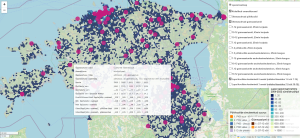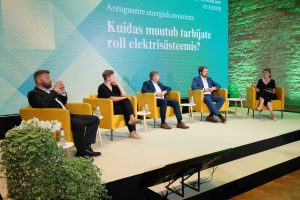According to Foresight Centre’s short report ‘Community Schools in Estonia’, transforming local schools and kindergartens into modern community houses would help to revitalise public services in danger of closure. For example, remote work offices, family doctor and youth centres, as well as various sports and hobby groups could be located there. However, although this model offers the greatest benefits to peripheral regions, the municipalities of Harju County are currently more active in creating such multifunctional houses.
News
Short-term energy storage would help solar panel owners to increase the profitability of their electricity production, which would also help keep the Estonian power system in balance, according to an analysis commissioned by the Foresight Centre.
The Foresight Centre created a map application of the Estonian school network, where you can see where Estonian schools are located and where children live. The application also shows the main indicators of general education schools for the last five years and a simulation of the schools’ futures based on today’s birth rates.
The increase in electricity microgeneration and the number of active consumers or prosumers in the power grid requires further development of the distribution network. This demands higher expenditures that the current network charges do not cover, which was the message at Foresight Centre’s Energy Conference ‘How will the role of consumers in the electricity system change?’.
Today, the Foresight Centre presented the report ‘Active Consumers in the Future Energy System’, which reveals that electricity management potential reaches 400MW in Estonia, exceeding the capacity of the Auvere power plant. The realisation of this potential is based on the assumption that electric cars and heat pumps become more widespread.
The Foresight Centre’s report ‘Active Consumers in the Future Energy System’ to be published this week states that although interest in electricity production has waned among the residents of Estonia compared to the peak of the energy crisis, the number of micro-producers in the Estonian energy system will grow up to four times by 2040. However, the increase of electricity-producing consumption does not jeopardise the balance and stability of the energy system.
People in Estonia have begun to consciously manage their electricity consumption during periods of high prices. This has helped reduce costs and better balance energy supply and demand. However, the potential for managing electricity consumption in Estonia is double that which is currently being seen, and its full implementation would require the amendment of legislation.
In Estonia, culture and sports are mostly reliant on public funds, while in the Nordic countries, for example, these sectors see significantly more private investment from companies and private individuals. In a recent short report, the Foresight Centre highlights how these sectors could receive over ten million euros more annually if Estonian companies raised their financial donations from the current 0.5% to 3%.
According to various assessments, the green transition will require funding equivalent to 2-4% of the national GDP annually for this and the next decade. In its yearbook published at the beginning of April, the Foresight Centre emphasises that the transition to an environmentally sustainable economic model will incur high costs for consumers and require supporting measures for successful implementation. However, the transition is predicted to bring benefits to the economy in the long term.
There are nearly 10,000 households in Estonia that both consume electricity from the distribution grid and produce electricity for the distribution grid. The calculations of the Foresight Centre indicate that on 130 days a year on average, the amount of energy supplied to the grid by households is greater than the amount of energy taken from the grid. In the case of prosumers who are legal entities, the amount of energy supplied to the distribution grid is greater than the amount consumed 96 days a year.

 An independent think tank at the Riigikogu
An independent think tank at the Riigikogu 





 Märt Masso, PhD
Expert of the Foresight Centre
Märt Masso, PhD
Expert of the Foresight Centre 

